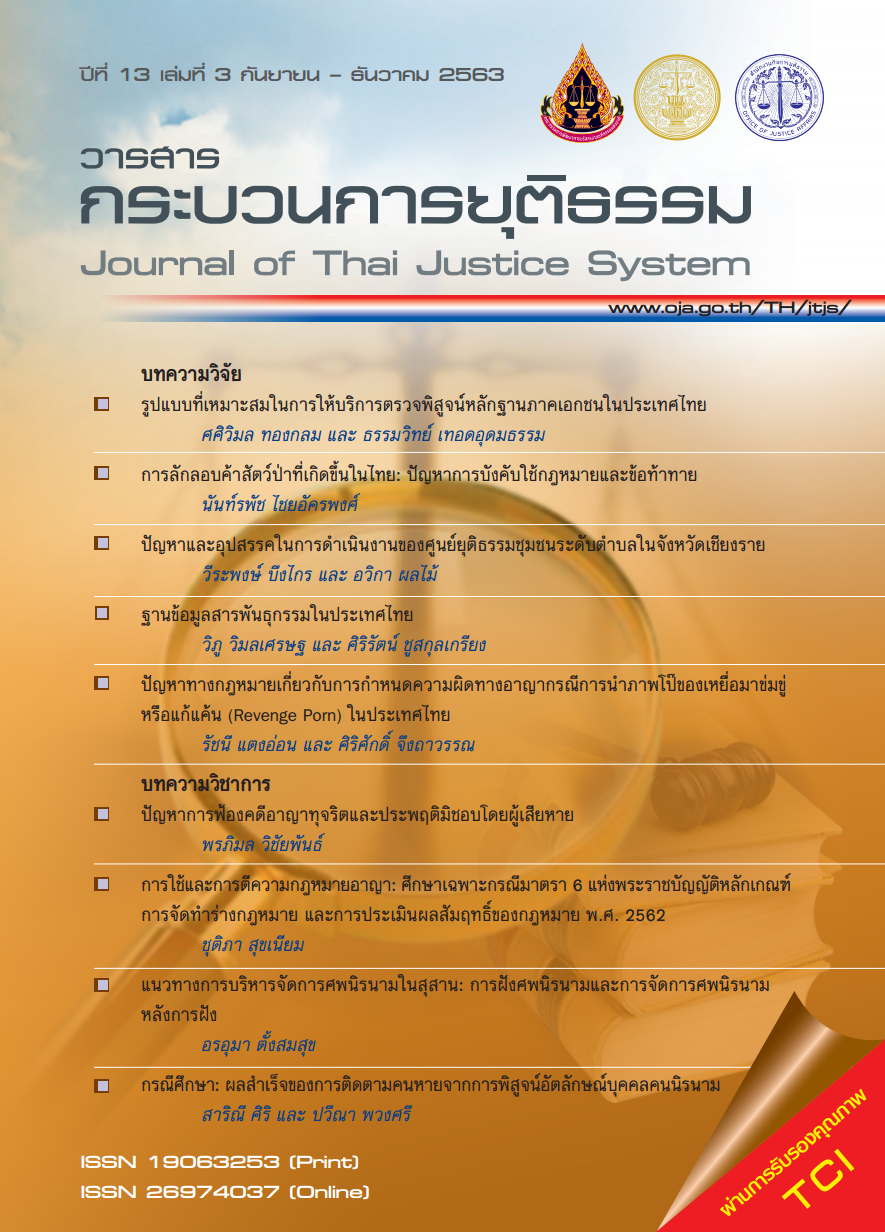กรณีศึกษา: ผลสำเร็จของการติดตามคนหายจากการพิสูจน์อัตลักษณ์บุคคลคนนิรนาม
Main Article Content
บทคัดย่อ
บทความนี้มีวัตถุประสงค์เพื่อศึกษาผลสำเร็จของการติดตามคนหายจากการพิสูจน์อัตลักษณ์บุคคลคนนิรนาม เพื่อประโยชน์ในการตรวจสอบยืนยันตัวตน การติดตามหาญาติ การวางแผนให้การคุ้มครองและดำเนินการตามกฎหมายที่เกี่ยวข้องกับภารกิจของกรมพัฒนาสังคมและสวัสดิการอย่างเหมาะสม สืบเนื่องมาจากบันทึกข้อตกลงความร่วมมือระหว่างสถาบันนิติวิทยาศาสตร์ กระทรวงยุติธรรม กับกรมพัฒนาสังคมและสวัสดิการ กระทรวงการพัฒนาสังคมและความมั่นคงของมนุษย์ ด้านการให้บริการตรวจทางนิติวิทยาศาสตร์เพื่ออำนวยความยุติธรรมช่วยเหลือสังคมและมนุษยธรรม โดยมีความเห็นร่วมกันที่จะประสานความร่วมมือในการดำเนินการแก้ไขปัญหาสถานะบุคคลของผู้ใช้บริการในความดูแลของกรมพัฒนาสังคมและสวัสดิการที่ไม่มีสถานะทางทะเบียนราษฎร เป็นบุคคลนิรนาม ซึ่งถูกทอดทิ้ง เร่ร่อน พลัดหลง ในที่สาธารณะ และไม่สามารถให้ข้อมูลเกี่ยวกับตนเองได้ ตลอดจนบุคคลที่นำเด็กมาเร่ร่อนหรือขอทาน ต่อมาวันที่ 29 พฤศจิกายน พ.ศ. 2560 สถาบันนิติวิทยาศาสตร์ได้ดำเนินการลงพื้นที่จัดเก็บข้อมูลภาพ รูปพรรณสัณฐาน แผลเป็น ตำหนิ รอยสัก ข้อมูลทางการแพทย์ ลักษณะพิเศษ สารพันธุกรรม และลายพิมพ์นิ้วมือของคนนิรนาม ณ สถานคุ้มครองคนไร้ที่พึ่งปรือใหญ่ จังหวัดศรีสะเกษ แล้วนำข้อมูลของคนนิรนามเหล่านั้นมาเปรียบเทียบกับฐานข้อมูลคนหายของสถาบันนิติวิทยาศาสตร์ พบว่า มีคนนิรนามที่มีข้อมูลอัตลักษณ์บุคคลสอดคล้องกับข้อมูลคนหายของสถาบันนิติวิทยาศาสตร์ที่ญาติได้มาแจ้งหายไว้เมื่อปีพ.ศ. 2555 ซึ่งคนหายได้หายออกจากบ้านประมาณปลายเดือนมกราคม ปีพ.ศ. 2555 แต่ยังไม่สามารถยืนยันได้ว่าเป็นคนหาย จึงได้ส่งตัวอย่างสารพันธุกรรมของคนนิรนามดังกล่าว เพื่อหาความสัมพันธ์ทางสายโลหิตกับรูปแบบสารพันธุกรรมภายในฐานข้อมูลสารพันธุกรรมบุคคลสูญหายของสถาบันนิติวิทยาศาสตร์ จึงทำให้สามารถยืนยันได้ว่าคนนิรนามนั้นคือคนหายที่แจ้งหายไว้ตั้งแต่ปีพ.ศ. 2555
Article Details
ต้นฉบับที่ได้รับการตีพิมพ์ในวารสาร เป็นลิขสิทธิ์ของวารสารกระบวนการยุติธรรม แต่ความคิดเห็นที่ปรากฏในเนื้อหาของบทความในวารสารกระบวนการยุติธรรม ถือเป็นความรับผิดชอบของผู้เขียนแต่เพียงผู้เดียว
เอกสารอ้างอิง
กฤษณะ สุวรรณภูมิ. (2562). แผนภูมิครอบครัว (The family genogram). ค้นเมื่อ 14 พฤษภาคม 2563, จาก https://www.slideshare.net/georgesonthi/genogram-130087454
ระเบียบสำนักนายกรัฐมนตรีว่าด้วยการสนับสนุนการปฏิบัติงานติดตามคนหายและพิสูจน์ศพนิรนาม พ.ศ. 2558. (2558). ราชกิจจานุเบกษา, 132(98ง), 2.
เลี้ยง หุยประเสริฐ. (2555). การพิสูจน์เอกลักษณ์บุคคล. ค้นเมื่อ 28 กุมภาพันธ์ 2561, จาก http://www.ifm.go.th/th/ifm-book/ifm-textbook/142-identification.html
สถาบันนิติวิทยาศาสตร์. (2562). แผนปฏิบัติการด้านคนหาย คนนิรนาม และศพนิรนามระยะที่ 1 (พ.ศ. 2563-2565) สถิติคนหายคนนิรนามและศพนิรนาม ตั้งแต่ปี พ.ศ. 2559 ถึง พ.ศ. 2562. กรุงเทพฯ: สำนักงานเลขานุการของคณะกรรมการพัฒนาระบบการติดตามคนหายและการพิสูจน์ศพนิรนาม(ค.พ.ศ.).
อภิชัย แผลงศร. (2555). การระบุบุคคล. ค้นเมื่อ 14 พฤษภาคม 2563, จาก http://med.swu.ac.Th/forensic/images/AP_Identification(new)%201_60.pdf
Interpol. (2014). Interpol Disaster Victim Identification Guide. Retrieved 16 July, 2020, from https://www.interpol.int/content/download/589/file/18Y1344%20E%20DVI_Guide.pdf
Scientific Working Group for Forensic Anthropology. (2010). Personal Identification. Retrieved 14 May, 2020, from https://www.nist.Gov/system/files/documents/2018/03/13/swganth_personal_identification.pdf


